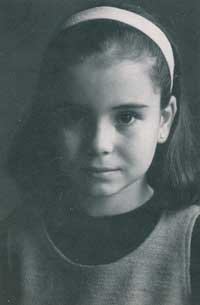|

Gloria Kehoe
(1954-1977)
(Ediciones Corregidor, 2004)
|
Kehoe, Gloria (1954-1977),
short-story writer, was born on 25 September 1954 in Buenos
Aires, the daughter of Ernesto Eliseo [Ernie] Kehoe
Wilson (1926-1986) and his wife Ercilia, née Ackermann Calvete
(1929-1998), a ceramics artist. Ernesto Kehoe worked in
advertising and real estate , and also produced the film Dar
la cara (1962). Gloria’s brother, Gustavo Kehoe (b. 1958), a
folk musician, works in the Argentine Lower House. Gloria
Kehoe's grandfather Eduardo Kehoe (1895-1941) was a manager at a
meat-packing company in Paraguay and also lived for a time in
Concordia, Entre Ríos province. The family descended from John
Kehoe (1821-1890) and Julia, née Robbins (1832-1877), immigrants
from the Irish counties Wexford and Offaly respectively, who
settled as sheep-farmers in San Pedro, 157 km north-west of the
city of Buenos Aires.
Gloria Kehoe's family was related to
Juan Bautista Justo (1865-1928), MP and founder of the Socialist
Party. Her great-grandfather was Col. Benjamín Calvete, a
veteran of the Argentine wars against the indigenous peoples in
La Pampa and the War of the Triple Alliance against Paraguay.
Her paternal grand-uncle Fr. Federico Richards C.P. (1921-1999)
was director of the Southern Cross, the Catholic
newspaper of the Irish community in Argentina. The family, of a
middle-class Irish and Swiss background, were intellectually
progressive and frequently received visits from artists who had
an influence on Gloria Kehoe's formative years.
Between 1961 and 1967, Kehoe was
sent to Esteban Echeverría public primary school in Belgrano.
She was subsequently enrolled at the Nacional Buenos Aires
school. Although she was an intelligent, above-average student,
her rebellious character triggered conflicts with teachers. She
was not allowed to enrol for her final year of secondary school,
and was forced to complete her secondary education at Nacional
Vicente López, where she graduated in 1973. In 1976 Gloria Kehoe
began studying literature at the University of Buenos Aires. She
also attended the Ateneo Evita in Belgrano, and went to writing
workshops offered by the Argentine Writers' Society (SADE).
Kehoe began writing stories at the
age of fifteen, under the guidance of her parents and friends,
including the writer Héctor Lastra. She worked diligently
writing and correcting manuscripts, and at the age of nineteen
she produced her first book, Pico de paloma (Dove’s
Beak), which was published on 21 April 1977 by Corregidor
publishers of Buenos Aires. Some of the short stories in this
book have received critical acclaim.. In 1975, 'El reemplazante'
won the González Tuñón award; 'El moro' was published for the
first time in the literary review of La Nación newspaper.
During her time at Nacional Buenos
Aires school, Gloria Kehoe joined various left-wing groups,
including the Socialist Revolutionary Students Trend (TERS)
within the Workers Party. In 1973 she was active in a unit of
the Juventud Peronista (Peronist Youth). However, in 1976 she
abandoned political activity to concentrate on the study of
literature and on writing.
According to colleagues and friends
who knew her in the mid-1970s Gloria Kehoe was an extremely
beautiful young woman, with black hair and distinctive brown
eyes. She was a determined person, sometimes moody, but usually
with a refined sense of humour and a clever conversationalist.
From 1974 Gloria Kehoe lived with
Adolfo Infante Allende (1940-1977), an activist in the Peronist
movement. They lived in an apartment at Quintana avenue, but
later the couple moved to Kehoe’s grandmother's house at 2212
Sucre street, in Belgrano district of Buenos Aires. They had
no children.
On the night of
13 June 1977 Gloria Kehoe and Adolfo Infante were abducted,
presumably by a navy death squad led by the intelligence officer
Jorge García Velazco, and were interned at the Navy Mechanics
School (ESMA) before being executed. Like many other family
members of 'disappeared' persons, Ernesto Kehoe and Fr. Federico
Richards sought the help of the Papal Nuncio in Buenos Aires,
Mgr. Pio Laghi. The Nuncio's secretary, an Irish priest called
Kevin Mullen who died in 1983 while acting as the Papal
representative's secretary in Cuba, told them that they had an
updated list of people killed by the military but her name was
not included.
Edmundo
Murray
References
-
Conadep, Nunca Más: Informe de la
Comisión Nacional sobre la Desaparición de Personas (Conadep)
(Buenos Aires: Eudeba, 2001). Fifth edition.
- Correspondence with Gustavo Kehoe
(3 January 2006).
- Goñi, Uki, The Silence of the
Bishops: Priest Scores Church's Role in Argentina's Dirty War,
in News Report (San Francisco, CA: Pacific News Service, 1995).
Available online (http://lanic.utexas.edu/la/region/news/arc/lasnet/1995/0470.html),
accessed 14 February 2006.
- Kehoe, Gloria,
Pico de paloma y otros escritos (Buenos Aires: Corregidor,
2004). First edition Corregidor, 1977.
- Margulis, Alejandro, Hermanos:
Gustavo Kehoe Wilson. Habría que reconstruir la historia de los
desaparecidos in 'Ayesha Libros'. Available online (http://www.ayeshalibros.com.ar/anteriores/reportajes/reportajeshermanoswilson.htm),
accessed 7 February 2006. |


